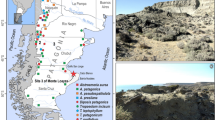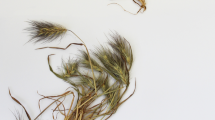Abstract
The dimensions of archaeobotanical grains identified as Panicum miliaceum (broomcorn millet) vary greatly in size. This is illustrated by the remains from the archaeological site of Zanovskoe in eastern Ukraine (5th–1st centuries cal. b.c.). We carried out experimental work on broomcorn millet plants and grains, aiming at a comprehensive understanding of factors that may have contributed to variation in the grain size of broomcorn millet in archaeobotanical assemblages. We analyzed the dependence of grain size variation on selected environmental and taphonomic factors. Our results indicate that immaturity is more likely than environmental stress to account for small grain size in broomcorn millet plants. Depending on charring temperature and time, immature broomcorn millet grains can withstand charring and are potentially preserved in archaeological assemblages. Depending on maturity level, such grains vary in size and shape. These results are potentially important for accurate identification of archaeobotanical specimens.







Similar content being viewed by others
References
Altenbach S, Dupont F, Kothari K, Chan R, Johnson E, Lieu D (2003) Temperature, water and fertilizer influence the timing of key events during grain development in a US spring wheat. J Cereal Sci 37:9–20
Baltensperger DD (1996) Foxtail and proso millet. In: Janick J (ed) Progress in new crops: new opportunities, new technologies. ASHS Press, Alexandria, pp 182–190
Baltensperger DD (2002) Progress with proso, pearl and other milllets. In: Janick J, Whipkey A (eds) Trends in new crops and new uses. ASHS Press, Alexandria, pp 100–103
Blum A (1998) Improving wheat grain filling under stress by stem reserve mobilisation. Euphytica 100:77–83
Braadbaart F, Poole I, Van Brussel AA (2009) Preservation potential of charcoal in alkaline environments: an experimental approach and implications for the archaeological record. J Archaeol Sci 36:1,672–1,679
Craufurd P, Peacock J (2008) Effect of heat and drought stress on sorghum (Sorghum bicolor) grain yield. Exp Agric 29:77–86
Dupont F, Altenbach S (2003) Molecular and biochemical impacts of environmental factors on wheat grain development and protein synthesis. J Cereal Sci 38:133–146
Fuller DQ (2006) A millet atlas: some identification guidance. University College London http://www.homepages.ucl.ac.uk/~tcrndfu/Abot/Millet%20Handout06.pdf. Accessed 27 Sep 2010
Fuller DQ (2007) Contrasting patterns in crop domestication and domestication rates: recent archaeobotanical insights from the Old World. Ann Bot 100:903–924
Hu Y, Wang S, Luan F, Wang C, Richards M (2008) Stable isotope analysis of humans from Xiaojingshan site: implications for understanding the origin of millet agriculture in China. J Archaeol Sci 35:2,960–2,965
Hunt HV, Vander Linden M, Liu X, Motuzaite-Matuzeviciute G, Colledge S, Jones MK (2008) Millets across Eurasia: chronology and context of early records of the genera Panicum and Setaria from archaeological sites in the Old World. Veget Hist Archaeobot 17:5–18
Ishimaru T, Ohsugi R, Matsuda T, Yamagishi T (2003) Morphological development of rice caryopses located at the different positions in a panicle from early to middle stage of grain filling. Funct Plant Biol 30:1,139–1,149
Jacob J, Disnar J, Arnaud F, Chapron E, Debret M, Lallier-Vergës E, Desmet M, Revel-Rolland M (2008) Millet cultivation history in the French Alps as evidenced by a sedimentary molecule. J Archaeol Sci 35:814–820
Kobata T, Palta J, Turner N (1992) Rate of development of postanthesis water deficits and grain filling of spring wheat. Crop Sci 32:1,238–1,242
Lee G, Crawford G, Liu L, Chen X (2007) Plants and people from the Early Neolithic to Shang periods in North China. Proc Natl Acad Sci USA 104:1,087–1,092
Liu X, Hunt HV, Jones MK (2009) River valleys and foothills: changing archaeological perceptions of North China’s earliest farms. Antiquity 83(319):82–95
Marinval P (1992) Archaeobotanical data on millets (Panicum miliaceum and Setaria italica) in France. Rev Palaeobot Palynol 73:259–270
Märkle T, Rösch M (2008) Experiments on the effects of carbonization on some cultivated plant seeds. Veget Hist Archaeobot 17:257–263
Pashkevich GA (2003) Palaeoethnobotanical evidence of agriculture in steppe and forest-steppe of East Europe in the Late Neolithic and Bronze Age. In: Levine M, Renfrew C, Boyle K (eds) Prehistoric steppe adaptation and the horse. McDonald Institute for Archaeological Research, Cambridge, pp 287–297
Pechenkina E, Ambrose S, Xiaolin M, Benfer R (2005) Reconstructing northern Chinese Neolithic subsistence practices by isotopic analysis. J Archaeol Sci 32:1,176–1,189
Renfrew JM (1973) Palaeoethnobotany: the prehistoric food plants of the Near East and Europe. Methuen, London
Saini H, Westgate M (1999) Reproductive development in grain crops during drought. Adv Agron 68:59–96
Savin R, Nicolas M (1996) Effects of short periods of drought and high temperature on grain growth and starch accumulation of two malting barley cultivars. Aust J Plant Physiol 23:201–210
Shah N, Paulsen G (2003) Interaction of drought and high temperature on photosynthesis and grain-filling of wheat. Plant Soil 257:219–226
Tafuri M, Craig O, Canci A (2009) Stable isotope evidence for the consumption of millet and other plants in Bronze Age Italy. Am J Phys Anthropol 139:146–153
Westgate M, Grant D (1989) Water deficits and reproduction in maize 1 response of the reproductive tissue to water deficits at anthesis and mid-grain fill. Plant Physiol 91:862–867
Yang J, Zhang J (2006) Grain filling of cereals under soil drying. New Phytol 169:223–236
Zohary D, Hopf M (2000) Domestication of plants in the Old World, 3rd edn. Oxford University Press, Oxford
Acknowledgments
This study was supported by the Gates Foundation and the Arts and Humanities Research Council. We are grateful to Sergey Telizhenko from the Institute of Archaeology in Crimea (Ukraine) for allowing access to sample archaeobotanical remains from the Zanovskoe archaeological site. We are grateful to Peter Michna and colleagues at the Cambridge University Botanical Gardens for providing experimental facilities and caring for plants.
Author information
Authors and Affiliations
Corresponding author
Additional information
Communicated by F. Bittmann.
Electronic supplementary material
Below is the link to the electronic supplementary material.
334_2011_322_MOESM1_ESM.pdf
Online Resource 1 Drawings of Panicum miliaceum panicles MIL-44 and MIL-66, showing the distribution of grain/scutellum size variation within each panicle (PDF 543 kb)
334_2011_322_MOESM2_ESM.doc
Online Resource 2 Data of all grain on panicle measurements from two broomcorn millet accessions (MIL-44 and MIL-66) (DOC 25 kb)
334_2011_322_MOESM3_ESM.doc
Online Resource 3 Measurements of broomcorn millet grains harvested at different stages after anthesis and exposed to different temperatures (DOC 32 kb)
Rights and permissions
About this article
Cite this article
Motuzaite-Matuzeviciute, G., Hunt, H.V. & Jones, M.K. Experimental approaches to understanding variation in grain size in Panicum miliaceum (broomcorn millet) and its relevance for interpreting archaeobotanical assemblages. Veget Hist Archaeobot 21, 69–77 (2012). https://doi.org/10.1007/s00334-011-0322-2
Received:
Accepted:
Published:
Issue Date:
DOI: https://doi.org/10.1007/s00334-011-0322-2




